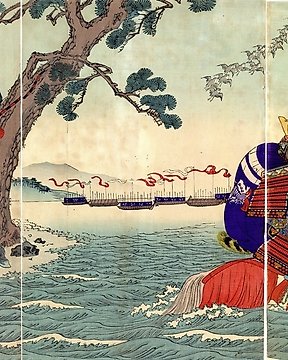
Origineel drieluik met houtsnede - Papier - Watanabe Yosai Nobukazu (1872-1944) - 'Kumagai naozane Atsumori wo Yobimodosu zu' 熊谷直実 敦盛ヲ呼戻図 (Kumagai Naozane and Taira no Atsumori) - Japan - 1893 (Meiji 26)
Nr. 82831399

Nr. 82831399

Original kuchi-e 口絵 (frontispiece) woodblock print - Paper - Kaburaki Kiyokata (1878-1972) - Illustration of the novel 'Otorige' 大鳥毛 from "Shin shōsetsu" 新小説 vol 16 - Japan - 1911 (Meiji 44)
Reasonable condition, stains, loss at bottom left corner
1878 (Meiji 11) Born August 31st in Kanda, Tokyo. He is his real name Kenichi. My father is one of the founders of “Tokyo Nichi Nichi Shimbun” (currently Mainichi Shimbun), and is an excellent literary writer who also worked on gesaku and drama reviews. Under the influence of his father, he grew up familiar with literary arts from an early age.
1891(Meiji 24), with the recommendation of his father and Sanyutei Encho, he became a disciple of Toshikata Mizuno with the aim of becoming an illustrator.
1893, he was awarded the title of “Kiyokata” by his master mizuno Toshikata.
1894, he was in charge of illustrations for “Yamato Shimbun,” whose father is the president.
1897, he was in charge of the illustration for “Tohoku Shimbun” and became independent.
1901, the “Ugokai(烏合会)” was formed. Kyoka Izumi was asked to make a frontispiece and a cover for the author “Sanmatsuzuki(三枚續)”.Around this time, he deepened his interest in Japanese painting and began to exhibit many works that were especially literary.
1903, he began to decorate the frontispiece of the magazine “Bungei Ikurabu”, which led the literary world, and solidified his position as an illustrator.
1915, Shinsui Ito, Shimei Terashima and other Kiyokata students formed the “kyōdokai(郷土会)”. At the 9th palindrome, “Hareyuki Murasame” won the highest award.
1916 “Kinreisha(金鈴社)” with Hirafuku Hyakusui(平福百穂), Matsuoka Eikyu(松岡映丘), Yuuki Somei(結城素明), and Yoshikawa Reika(吉川霊華) Formed.
1919, he served as a judge for the 1st Imperial Art Institute Exhibition (Imperial Exhibition帝国美術院展).
1927 Exhibited “Tsukiji Akashicho” at the 8th Imperial Exhibition . Received the Imperial Art Academy Award
1930 Exhibited “Sanyutei Encho Statue” at the 11th Imperial Exhibition.This work was designated as an important cultural property in 2003.
1944, he was appointed as an imperial artist.
1946 He is a judge of the 1st Japanese Art Exhibition (Nitten) . He moved to Kamakura Zaimokuza from Gotemba, where he was evacuated, because his home in Yaraicho, Ushigome was burned down in the war.
1954He received the Order of Culture. He moved to Yukinoshita, Kamakura.
He passed away on March 2, 1972, in Yukinoshita, Kamakura. He is 93 years old.
Zo koop je op Catawiki
1. Ontdek iets bijzonders
2. Plaats het hoogste bod
3. Veilig betalen